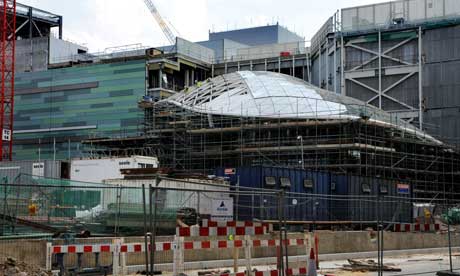Bristol City Council have finally summoned up the courage to push through changes to bring to an end the intolerable situation on Prince Street Bridge
(map) where large numbers of pedestrians have to use
footways just 1 metre wide, too narrow for two people to pass comfortably, with traffic passing just inches away.

Previous
attempts to resolve this situation have seen the Council back down in the face of objections from some motorists, vociferously articulated through the Evening Post, who believe that any restriction of car traffic on Prince Street Bridge will have a knock-on effect elsewhere, mainly on the nearest alternative route crossing the Floating Harbour via
Redcliffe Bridge.
Significantly widening the narrow
footways is not possible without displacing motor traffic since the adjacent roadways are themselves only 2.4 metres wide (the width of a bus) and wide vehicles are already prohibited. The Council also want to run buses over the bridge as part of their proposed
BRT route from Ashton Vale to Temple
Meads which would not be possible with the current arrangement.

The Council
Press Release attempted to slip the news out buried in with lots of other detail of measures proposed for the initial stages of the Cycling City project, but it seems that the Evening Post spotted it and gave it front page treatment under the headline
"farcical", backed up with a biased
editorial comment, in line with its previously hostile and extremely partial coverage. The relevant section of the Press Release is -
"The first phase of Cycling City work also proposes to deliver an improved route for cyclists and pedestrians alike across the city's Prince Street bridge. This narrow swing bridge over the historic Floating Harbour has a slim pavement on one side only and poses a danger for cyclists, pedestrians and motorists as they compete for limited road space. The Cycling City proposal will see the introduction of more space for cyclists and pedestrians on the same side as the existing footpath, with traffic lights providing alternative one way working for motorists - carefully managed to keep traffic moving smoothly during peak hours."
Of course the Council managed to get the facts wrong, stating that "
This narrow swing bridge over the historic Floating Harbour has a slim pavement on one side only". Really? As the pictures here show it has
footways on both sides. So where did they get this notion that it only has one
footway from? My guess is that they've let slip that they intend to remove one of the two
footways in order to allow buses to cross.

If so then it looks as if all the pedestrians and all the cyclists are going to be pushed onto the west (left in pics) half of the bridge which is only 3.5 metres wide overall. During peak times pedestrian and cycle flows are already large and likely to grow, especially if conflict with motor traffic is diminished and the route from
Southville (Gaol Ferry Bridge) to the centre and
Harbourside (via
Pero's Bridge) become increasingly attractive.
Two-way cycle and pedestrian paths each need to be at the very least least 2 metres wide if conflict is to be avoided and when flows are as high as they are in this case at least 2.5 metres would be indicated. So there is clearly no chance of accommodating separate cycle and pedestrian paths of adequate width.
What about a common shared path then? This would be the optimal way of using the restricted width (so probably not what is planned!) and would be similar to the situation on
Pero's Bridge (width 3 metres), but given the higher flows of commuters in a hurry, and especially the much higher number of cyclists, it must be questioned whether this is wise.
At present cyclists have the use of 2.4 metre roadways in each direction and pedestrians have 1 metre paths on both sides. The proposed changes, if they include scrubbing the east side
footway as suspected, will effectively halve the overall width available to cyclists and pedestrians combined, yet the Press Release claims "
The .. proposal will see the introduction of more space for cyclists and pedestrians...". Only Bristol City council could manage such an absurd claim.

However the 3.5 metres is sub-divided between cyclists and pedestrians we both will end up with less space than we currently enjoy, albeit replacing conflict with cars for conflict with each other. There have been many earlier examples of the Council attempting to 'improve' conditions for cyclists by forcing them onto
footways where they come into conflict with pedestrians and such conflict is becoming an issue of major public concern. Do we really want more of it?
There is an alternative. If both halves of Prince Street Bridge were closed to motor traffic and one half (the west side) allocated exclusively to pedestrians and the other exclusively to cyclists both would enjoy relaxed and safe conditions. A complete closure to motor traffic would also improve conditions on the approaches to the bridge as
Wapping Road would then become largely motor traffic free rather than full of queuing cars with engines running.
Needless to say the Evening Post and certain businessmen based in Queen's Square would go ballistic if faced with such a proposal, but sooner or later that reactionary attitude has to be confronted if we are to make any real progress towards a civilised and healthy city environment, so why not now?

Cycle commuters waiting for Prince Street Bridge to open in 1964.






























